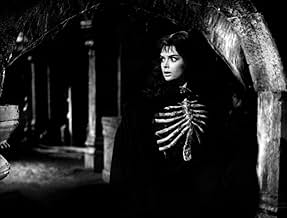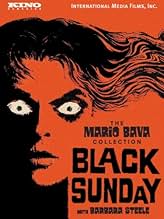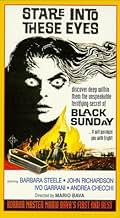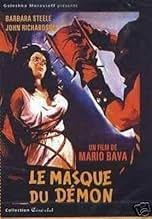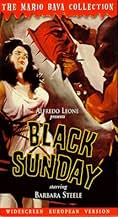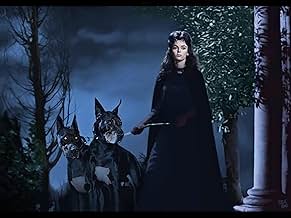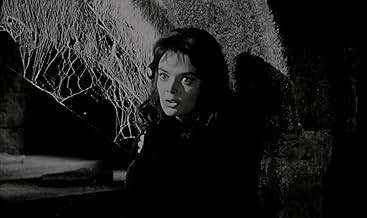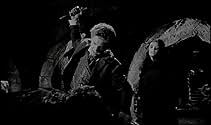CALIFICACIÓN DE IMDb
7.1/10
19 k
TU CALIFICACIÓN
Una bruja vengativa y su sirviente diabólico regresan de la tumba y comienzan una campaña sangrienta para poseer el cuerpo de la hermosa descendiente de la bruja.Una bruja vengativa y su sirviente diabólico regresan de la tumba y comienzan una campaña sangrienta para poseer el cuerpo de la hermosa descendiente de la bruja.Una bruja vengativa y su sirviente diabólico regresan de la tumba y comienzan una campaña sangrienta para poseer el cuerpo de la hermosa descendiente de la bruja.
- Dirección
- Guionistas
- Elenco
- Premios
- 1 premio ganado y 1 nominación en total
Barbara Steele
- Princess Asa Vajda
- (as Barbara Steel)
- …
Giuseppe Addobbati
- Priest
- (sin créditos)
Fernando Cajati
- Crucifixion Torturer
- (sin créditos)
Valentina Cortese
- Tavern Girl
- (sin créditos)
Angelo Galassi
- Tavern Keeper
- (sin créditos)
Nando Gazzolo
- Narrator
- (voz)
- (sin créditos)
Renato Montalbano
- Spectator
- (sin créditos)
Opiniones destacadas
The screenplay is hackneyed ,the story has been told told and told again...
And however,Bava's film is a sparkling diamond.How come?The direction of course,the cinematography absolutely incredibly breath-taking,and Barbara Steele ,the par excellence Gothic heroine:her fans will rejoice for she plays two parts here! Bava has no match when it comes to use the light the settings and the soundtrack.It's a black and white work and had it been filmed in color it would not have been better.From the gloomy family vaults to the forest where danger awaits on the young peasant girl to the doomed castle where a family tries to fight against a mysterious curse.
The carriage which takes the doctor to the mansion and its coachman reminds me of Murnau's "Nosferatu" .No less.
And however,Bava's film is a sparkling diamond.How come?The direction of course,the cinematography absolutely incredibly breath-taking,and Barbara Steele ,the par excellence Gothic heroine:her fans will rejoice for she plays two parts here! Bava has no match when it comes to use the light the settings and the soundtrack.It's a black and white work and had it been filmed in color it would not have been better.From the gloomy family vaults to the forest where danger awaits on the young peasant girl to the doomed castle where a family tries to fight against a mysterious curse.
The carriage which takes the doctor to the mansion and its coachman reminds me of Murnau's "Nosferatu" .No less.
'Black Sunday's reputation grows with every year that passes, and watching it it's no wonder why! It is not only one of the three or four best horror movies ever made, it is one of the most extraordinary movies of any genre I've ever seen. Mario Bava went on to direct several movies of note after this, but if he hadn't and this was the only movie he made, he would still be a legend. On a relatively small budget, but with buckets of talent, style and originality, Bava conjured up one of the most atmospheric and haunting movies of all time. He may not be the household name he deserves to be, but he is a film makers film maker with an enormous influence on not only subsequent Italian horror giants Dario Argento and Lucio Fulci, but directors as diverse as Tim Burton (who rates this as an all time favourite) and even Martin Scorsese. 'Black Sunday' will also be remembered as one of Barbara Steele's most memorable roles. Steele is best known for her work in 60s European horror movies, but in her career worked with everyone from Fellini to Cronenberg. If she is to be remembered for only one movie it will be this one. Steele was one of the most beautiful actresses to ever set foot in front of a camera, and it is impossible to imagine anyone else in the lead (duel) role. The supporting cast is fine, and includes the fondly remembered John Richardson ('One Million Years B.C.'), but this is Steele's show all the way. 'Black Sunday' is still fresh and exciting over forty years after it was originally released. A landmark movie that deserves to be watched again and again!
For some unknown reason, here recently I've been in the mood to watch a lot of vintage 1960s-70s Italian horror movies. Hardly any other film comes as highly recommended as Black Sunday and after viewing this incredibly moody effort, I can easily see why. It's by far one of the most beautifully photographed films I've seen of any genre. It's also one of the most atmospheric; a sense of horror and dread hang over every frame, and yet it is a film whose power does not lie entirely in the narrative. It's hidden somewhere, pretty much everywhere... in dark corners, in secret crypts, in fog, in shadows... The shots in this film are brilliantly composed. It is a true triumph for director and cinematographer Mario Bava, who provides such rich, dream-like technical depth that (pardon the cliché) this film truly does transport viewers somewhere else in time.
Even though this movie is best appreciated as an exercise in style and technique, the plot line (witch who is executed and returns centuries later to get revenge on the descendants of her executioners) is also enjoyable. So is Barbara Steele, who is ideally cast in a dual role as both the evil witch and the pure heroine. She's an actress who can switch from innocent and ravishing to hideous and horrific with the flick of an eyelash. No wonder she's considered the queen of horror. She deserves to be.
Even though this movie is best appreciated as an exercise in style and technique, the plot line (witch who is executed and returns centuries later to get revenge on the descendants of her executioners) is also enjoyable. So is Barbara Steele, who is ideally cast in a dual role as both the evil witch and the pure heroine. She's an actress who can switch from innocent and ravishing to hideous and horrific with the flick of an eyelash. No wonder she's considered the queen of horror. She deserves to be.
Whoever said a horror movie can't be beautiful? Thanks to actress Barbara Steele's stunning good looks and director Mario Bava's striking visual sense, that's exactly what BLACK SUNDAY is! The plot deals with a witch and her vampire-like lover who return from the grave to seek revenge on the descendants of those who burned her at the stake over one hundred years before. As is usually the case with Bava, style is way more important than substance, though the plot isn't bad for such a Gothic horror film. Barbara Steele appears in a dual role: a beautiful and pure princess, and the wicked witch who wants to take over her body. Steele is magnificent in both roles, and Bava's direction is as solid as can be. This film is truly a classic of the genre and demands multiple viewings. Horror fans must not miss it!!!!!
Be sure and watch the uncut version with the title "The Mask of Satan," not the censored "Black Sunday" copy, to get the full effect of this living dead masterpiece of Italian cinema. More a movie of the undead than a vampire flick, it reminds the horror aficionado of a Val Lewton film from the 1940's, especially "The Leopard Man," not that "The Mask of Satan" is about leopards, but the mood and atmosphere are similar.
The film is about a woman of darkness and her mate who were executed for witchcraft two centuries before the Napoleonic period of European history. The most gruesome feature of the execution involved nailing a mask of Satan to their faces by means of a giant sledgehammer before they were entombed. By accident two hundred years later a doctor and his assistant while journeying through the region by coach on a dark stormy night filled with eerie devilish sounds, the doctor removes the mask from Princess Asa Vajda supposed corpse. Now Princess Vajda and her fiendish companion become free to seek their revenge. Their evil is released on the world and must be stopped.
This is undoubtedly director Mario Bava best film. The marvelous camera work draws the viewer into the maelstrom of darkness and evil through innovative movements and angles. The shadowy settings where the actors are posed in ominous fashion are unforgettable. One obvious inspiration for Bava was the contemporary British Hammer horror film popular in America, especially with the drive-in crowd. The arrival of Katia Vajda with what appear to be the dogs of Hell, standing like a silhouette of damnation, reminds one of a Caspar David Friedrich painting from the German Romantic art movement of the Napoleonic era. One wonders if the director of "The Omen," Richard Donner, patterned his creepy scene in the cemetery with the Rottweilers after this scene in "The Mask of Satan."
This movie remains a must see for horror fans, somewhat of a lost treasure.
The film is about a woman of darkness and her mate who were executed for witchcraft two centuries before the Napoleonic period of European history. The most gruesome feature of the execution involved nailing a mask of Satan to their faces by means of a giant sledgehammer before they were entombed. By accident two hundred years later a doctor and his assistant while journeying through the region by coach on a dark stormy night filled with eerie devilish sounds, the doctor removes the mask from Princess Asa Vajda supposed corpse. Now Princess Vajda and her fiendish companion become free to seek their revenge. Their evil is released on the world and must be stopped.
This is undoubtedly director Mario Bava best film. The marvelous camera work draws the viewer into the maelstrom of darkness and evil through innovative movements and angles. The shadowy settings where the actors are posed in ominous fashion are unforgettable. One obvious inspiration for Bava was the contemporary British Hammer horror film popular in America, especially with the drive-in crowd. The arrival of Katia Vajda with what appear to be the dogs of Hell, standing like a silhouette of damnation, reminds one of a Caspar David Friedrich painting from the German Romantic art movement of the Napoleonic era. One wonders if the director of "The Omen," Richard Donner, patterned his creepy scene in the cemetery with the Rottweilers after this scene in "The Mask of Satan."
This movie remains a must see for horror fans, somewhat of a lost treasure.
¿Sabías que…?
- TriviaMario Bava and Barbara Steele had a difficult working relationship. She sometimes refused to come to set because she did not like her wig or the fact that her cleavage would be shown. One time she refused because she believed Bava would force her to appear nude. She admits that she was difficult due to her inexperience and inability to understand Italian.
- ErroresIn the opening credits, Barbara Steele's name is misspelled as Barbara Steel.
- Citas
Princess Asa Vajda: You, too, can feel the joy and happiness of hating.
- Créditos curiososFor "The Mask of Satan," the English language version prepared in Italy, Barbara Steele's name is listed as "Barbara Steel" on the trailer and on the credits of the film itself.
- Versiones alternativasThe full list of differences between the 83-minute original cut and the 80-minute AIP cut:
- A different English-language dub, and a new score by Les Baxter.
- An added pre-text crawl warning the audience about the film's content: "The producers of the picture you are about to see feel a moral obligation to warn you that it will shock you as no other film ever has. Because it could be very harmful to young and impressionable minds, it is restricted to only those over fourteen years of age."
- Alternate opening credits.
- A brief exchange between Katja and Constantine where he tells her their father has died is cut.
- A scene where Katja and Andrej talk in the garden is cut.
- An exchange between Katja and Andrej outside her room is cut.
- Kruvajan's death scene is cut down significantly to remove shots of his eye spurting blood.
- The scene were Prince Vajda reanimates and menaces Katja is trimmed.
- Vajda's death scene, particularly the close-ups of his head melting, is trimmed.
- Asa taunting Andrej before being burned at the stake is cut.
- Added closing credits.
- ConexionesFeatured in Los motorizados (1962)
Selecciones populares
Inicia sesión para calificar y agrega a la lista de videos para obtener recomendaciones personalizadas
Detalles
- Tiempo de ejecución
- 1h 27min(87 min)
- Color
- Mezcla de sonido
- Relación de aspecto
- 1.66 : 1
Contribuir a esta página
Sugiere una edición o agrega el contenido que falta


